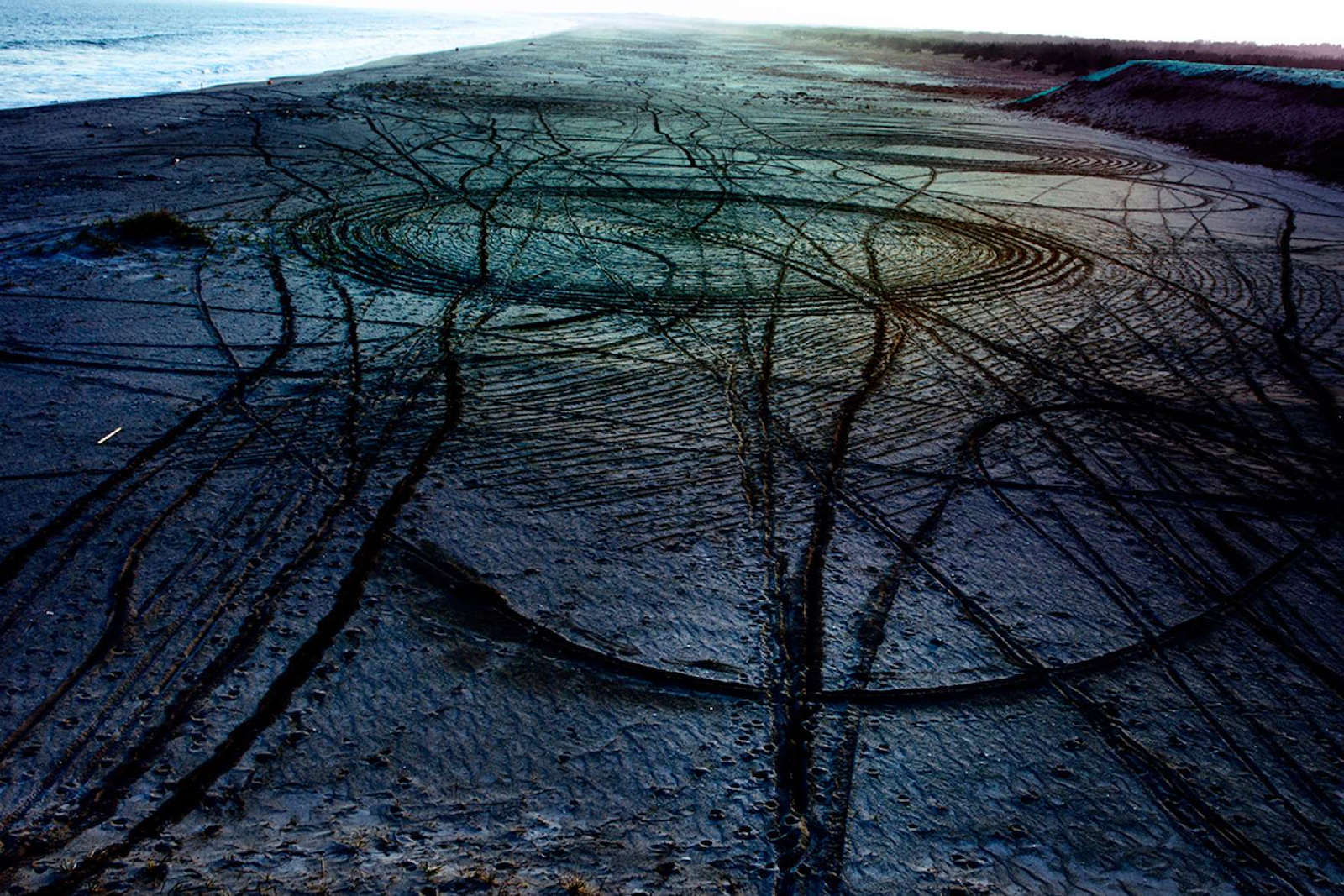
Culture
Fukushima 2016: Photo Exhibitions
Two photographic exhibitions documenting Japan’s Fukushima disaster have been mounted this spring at New York’s Asia Society and Japan Society.
Although these exhibits depict the same events, the impacts are strikingly different. The exhibit at Asia Society, a portion of which has also been mounted on the Asia Society website, strives for hope in the aftermath of disaster. It portrays specific locales in 2011 and again in 2015, documenting the ways in which reconstruction has overcome the devastation. The Japan Society exhibit is much darker- it has a surreal and ominous feel, despite the beauty of its images. It aims to be both artistic and a documentary. And indeed, the curators of “In the Wake: Japanese Photographers Respond to 3/11,” at Japan Society New York remark that the triple catastrophes of Japan’s 3/11 have been documented more completely than any of their disaster predecessors.
The Japan Society exhibit gives us a sense of this drive to fix in memory the events of 3/11- by the photographers of Japan, whether professionals, emerging or amateurs. It conveys a sense of the shock, dislocation, devastation, and a world turned upside down. The sense of danger and menace are lurking always below ordinary life, deep into the irradiated soil of existence. The need is to find meaning and even hope- whether it be in the image of a single pine tree still standing, or a double rainbow over a countryside of rubble. Or in the photos of ordinary people resolutely living their lives even after the catastrophes.
I will comment on images which linger in my mind’s eye.
An ostrich, for example, pacing the evacuated streets of a Fukushima town. Although at first the image of an exotic alien animal seems so improbable as to have been photo-shopped, the ostrich was quite real: it was the former mascot of TEPCO. It might equally well have been one of the abandoned animals rescued by Naoto Matsumura, who lives in the exclusion zone and cares for Fukushima’s 50 cows, two ostriches, dogs and cats left behind by fleeing residents.
Many of the images in this collection simply document the destruction; others like that of this unlikely pedestrian create this sense of distorted reality. Images like these make their point that 3/11 left behind a world devastated, gone horribly wrong, perhaps never to be righted.
A couple of examples: a now familiar trope, that of the wrecked ship on dry land rearing up at an impossible angle behind houses or warehouses, followed by the image of a large concrete structure apparently ripped in half, posed like a classical statue. And flanked by the now all too familiar post tsunami rubble.
Some images have achieved a kind of immortality. The lone “miracle pine” which survived the tsunami and still stands, is pictured standing alone in deep snow by the water. It occupies an enduring place in the national imagination like of that of St. Paul’s in London’s Blitz. “This 25-meter-tall tree in Minami Soma, which measures 2 meters in circumference, has been said to ‘symbolize hope for reconstruction of the local community.’”
Others require footnotes for viewers to recognize their significance. A beautiful and striking series of images by Shimpei Takeda of pinprick bright spots against a black background, which closely resemble portrayals of stars and galaxies, actually depict radiation. Takeda used irradiated soil to create a direct physical record of the catastrophe.
A series of images of Fukushima mushrooms by Takashi Homma also requires more than a footnote. These mushrooms, irradiated and thus prohibited from being consumed, still grow in the forests of Fukushima. Unfortunately, these pictures are so glossy and reflect their exposure to radiation so invisible to the naked eye that the viewer comes away wondering why they were included – when they might just as well belong to a gardening catalog or a cookbook.
Tomoko Yoneda’s surreal photos convey a sense of the post Fukushima menace now lurking beneath the everyday. “Chrysanthemums” shows us three poisonous jellyfish- like white blossoms floating above muted grey stalks and leaves against a stark black background– possibly a reference to the towers of the Dai Ichi Kangyo power plant. Her “Evacuated village, Iitate, Fukukushima Prefecture,” is a composition of five lighted structures floating above a black background, linked by a tiny spectral string of red lights. Flowers and a village have been turned into an ominous abstract painting.
The largest display was of three giant walls populated by innumerable small plaques of amateur photographs, which document ordinary life before and after the catastrophes, damaged by radiation and by immersion in water or soil. The damage has rendered these images a kind of unexpected artistic value- they seem to be composed of abstract figures spotted with blotches and blurs. These photos, have become a means for Fukushima residents to hang onto the vanished past and cling to some hope for the future. Viewers in New York tend to stand immobilized in front of this display for many minutes.
In contrast, the Asia Society has mounted both a real and a virtual exhibition on its website of photographs of Fukushima in 2011 after the tsunami and the rebuilding five years afterwards in 2015. The website exhibition has been said to convey a possible sense of Japan’s renewed optimism and hope for permanence.
Photographer James Whitlow Delano, who documented the devastation shortly after the 3/11 earthquake and tsunami, returned to Fukushima in 2015 to create images of the present day. The exhibition, available at the Asia Society New York and also at Asia Society’s website, is cleverly mounted on the website so that one can view 2011 and 2015 by sliding the slider browser from left to right, thereby viewing the emergence of the changed image at his/her own speed.
These images juxtapose ruined buildings and debris, homes and boats and municipal structures, with images of cleared debris, raised city streets, rebuilt homes- conveying hope for renewal.
Although the tone is generally optimistic, this is not a picture of unmixed positivity. The pictures also note many areas where devastation still lurks, reminders of the earthquake and tsunami: ruined buildings, black plastic sacks filled with irradiated soil, reconstruction of offices and homes still ongoing after five years.-one particularly sad comment – the cherry trees of Ofunato which flowered in spring of 2012 have been removed and the area is now devoid of vegetation.
The first image of March 2011 taken from the website shows an elderly woman on the road at the edge of Rikuzen-Takata, Iwate Prefecture, a city almost wiped out by the tsunami. Five years later, a ruined apartment building still stands. But rock blasted from the mountains has been transported to raise the city nearly 150 feet —to make it safer for returning inhabitants.
In an image of a spot near Minami Soma, Fukushima Prefecture: a barrier demarcates the 12-mile, nuclear, no-entry zone in 2011. Five years later, residents have returned to their homes — yet thousands of black sacks filled with irradiated soil are still present.
The third depicts Rikuzen-Takata in the aftermath of the tsunami. Debris reached the rooftops. The rest of the city was completely leveled, and about 5,000 of the city’s houses were submerged by the tsunami. Five years later, the debris has been cleared and the ground level raised another 50 feet.
In a picture of Ofunato, 2011: a tug boat, homes, and debris tossed about by the tsunami waters are shown deposited more than 1 kilometer away. Although the cherry tree in the middle of the photograph bloomed the following spring, five years later both trees have been removed and the riverside is devoid of any vegetation at all.
In Toni, Iwate Prefecture, the tsunami wall is shown as unable to hold back the wave that hit these homes. Many were damaged up to the second floor. Five years later, the tsunami wall and harbor repairs continue.
Whether one comes away from these exhibits with the memory of the lonely ostrich, or the lone pine, or the black plastic sacks of irradiated earth, or the lost cherry trees of Ofunato, or the recovered memories of the Lost and Found Project or whether one hopes with Tomoko Yoneda that those who have suffered through the events of Fukushima have begun to rise up in protest, or with others that Japan is experiencing a renewed sense of itself – these images may offer the special insight that art can bring to terrible events.

